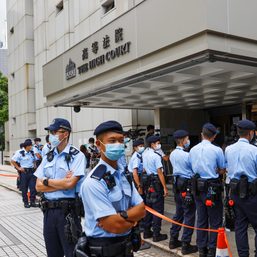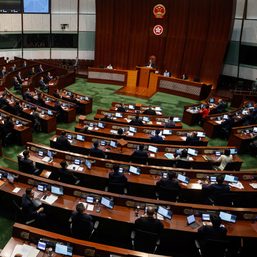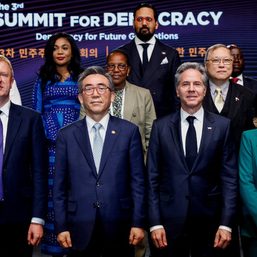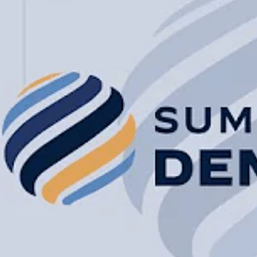SUMMARY
This is AI generated summarization, which may have errors. For context, always refer to the full article.
![[Newsstand] What does democracy look like to you?](https://www.rappler.com/tachyon/2021/11/tl-democracy-to-you-ls.jpg)
Henry Jenkins of the Center for Future Civic Media once posed a question that struck me as both fundamental and provocative. “What does democracy look like?”
I am reminded of that question because my answer, at that time, came in the form of an excellent photograph taken by the great photojournalist Romy Gacad. Unfortunately, I cannot share the photograph, which you can find on Getty Images; I asked permission to share it on social media, for free, as a small tribute to Romy, who passed away last Sunday. But the terms did not allow it.
However, all you need to do to find the photograph is search for “Arroyo Gonzalez Salcedo Lagman Solidum” on Google Images. It should be the first image you’ll see.
The photo was taken on August 12, 2006, when then-president Gloria Arroyo visited Legaspi City in Albay province. I was then editing a regional newspaper for the Inquirer called Compact, and was choosing pictures to run that day. There were very many photos, perhaps over a hundred, that were taken that day of that presidential visit, from different wire services as well as in-house photographers. Romy himself took many photos. But this one stood out, because it was taken at the right moment, and its perfect composition – President Arroyo on the left, under an umbrella held by a close-in aide; the other officials forming a perfect triangle, like a phalanx of obedient soldiers looking at their commander, on the right – spoke to me and to others about the geometry of power.
Exact composition
I was moved enough to write on my blog the next day:
“This photo, taken yesterday by the peerless Romy Gacad of AFP in the vicinity of Mayon volcano, spoke to me on so many levels I knew I just had to use it in a page I was closing in Compact. (I hope AFP doesn’t mind if I reproduce it here.) I looked at a couple of other newspapers today, but I haven’t seen anyone else use this. A pity. The composition is so exact it seems almost posed, until you consider the subjects involved: President Arroyo, of course, under the umbrella, facing (or receiving tribute from) Albay Gov. Gonzalez, Reps. Salceda and Lagman, and volcanology institute chief Solidum. (Note the triangle that the officials form.) Other photos, taken by Gacad and by other photographers too, remind us that this particular tableau was very much a product of the moment; in fact, most of the pictures taken at this volcano-gazing event yesterday show either the President by herself or in a huddle with officials. But the veteran lensman saw something different, perhaps a shift in movement, perhaps a blurring and then a coming-into-focus of color. Was it perhaps the presidential umbrella that drew his attention? The result is certainly one worth saving for that proverbial rainy day.”
In a speech before the American Studies Association of the Philippines in November the following year, I drew attention to the image again.
“In the 15 months since I wrote that [blog post], I have become more and more convinced that this candid portrait of the hierarchy of political power, caught on the wing, tells us something true about democracy, Philippine-style.
“But if this is democracy, where are the demos? Three possibilities. The people are implied; the leaders from the executive and the legislative branches are discussing their fate. The people have been warned off; note the sign that can be glimpsed in the space between the President and her umbrella-toting guard. If we fill in the blanks, we can read: Warning Don’t Go Beyond The Line. Not least, the people (and the press) are outside the frame, watching the scene.
“You may have other images in mind that illustrate democracy, Philippine-style. Any of the iconic photographs from the four heady days of Edsa Uno, for instance, would be similarly evocative. Familiar images of Philippine elections – yellow ballot box, blue-stained index fingers, seminarians in white – remain resonant. A photograph taken by Inquirer photographer Rem Zamora during special elections last May casts the eternal triangle of ballot box, armed guard, and election volunteer in a new light, literally through a different grid.
“But back to Bicol. I hope you will agree with me when I say that the Gacad photo does two things wonderfully well: It captures the elite nature of our representative democracy today, and at the very same time it recalls the datu-and-tribute origins of our history.”
Romy’s legacy
I remember all this today, in honor of the legacy of the great Romy Gacad.
At the same time, I am aware that, if the question were asked today – “What does our democracy look like?” – I would have a different answer.
It could be any of a series of photos taken of President Duterte’s running mate in 2019, awkward and craven before him. “The images were distasteful,” I wrote then. “They showed Rep. Alan Peter Cayetano bowing low before President Duterte, who had just anointed him Speaker of the House of Representatives. He is doing the ‘mano,’ the Filipino ritual of respect, but something is wrong. He is bowing too low, and the President does not seem to like it. In the way the President angles his body, which suggests that he is taking away his hand, and in the way his face is set, the President seems to be expressing his own distaste.”
It could be any of those photographs, now suspect, that Senator and presidential aide Bong Go showed, of President Duterte allegedly walking on the Palace grounds, or riding a motorcycle – in an obvious attempt to deflect attention from yet another of the absentee President’s long absences. I wrote then: “In the last two weeks, the President of the Philippines was quite literally absent. In his stead, his personal aide Sen. Bong Go foisted suspicious photos and video clips of President Duterte on the public; it was, yet again, another moment in the Duterte presidency when proof of life was needed because the President was nowhere to be found. But instead of proof of life (many people remarked on the President’s different hairlines, for instance, which seemingly varied from day to day), Go’s manufactured images instead provided clear proof that – in the worst two weeks of the 14-month-long pandemic – the President was supposedly jogging, apparently golfing, actually breaking curfew. In other word: useless.”
Or perhaps it is not a photograph, but a piece of paper. “The national interest in the Pharmally issue is as clear as the presidential seal on Michael Yang’s business cards. By defending Yang and attacking the (recently emboldened) Senate, the President of the Philippines is unapologetically siding against the Philippines.”
Does our democracy today look like that once great seal: cheapened, rationalized, denied? – Rappler.com
Veteran journalist John Nery is a columnist and editorial consultant of Rappler.
Add a comment
How does this make you feel?





There are no comments yet. Add your comment to start the conversation.